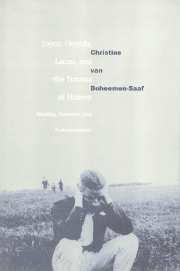Book contents
- Frontmatter
- Contents
- Acknowledgments
- List of abbreviations
- Chapter 1 The stolen birthright: the mimesis of original loss
- Chapter 2 Representation in a postcolonial symbolic
- Chapter 3 The language of the outlaw
- Chapter 4 The primitive scene of representation: writing gender
- Chapter 5 Materiality in Derrida, Lacan, and Joyce's embodied text
- Conclusion: Joyce's anamorphic mirror
- Bibliography
- Index
Conclusion: Joyce's anamorphic mirror
Published online by Cambridge University Press: 22 September 2009
- Frontmatter
- Contents
- Acknowledgments
- List of abbreviations
- Chapter 1 The stolen birthright: the mimesis of original loss
- Chapter 2 Representation in a postcolonial symbolic
- Chapter 3 The language of the outlaw
- Chapter 4 The primitive scene of representation: writing gender
- Chapter 5 Materiality in Derrida, Lacan, and Joyce's embodied text
- Conclusion: Joyce's anamorphic mirror
- Bibliography
- Index
Summary
What can't be coded can be decorded if an ear aye sieze what no eye ere grieved for.
Finnegans WakeTrauma is the curious condition of a split and yet redoubled state of being: death-in-life. Death has been felt, but has not been accepted. Although the conscious memory of the occasion is lacking, death has inscribed itself on the psyche and/or in the body, and insists on manifesting itself as the compulsion to repeat. A force stronger than the will programs the self, seemingly from outside; exiled from self-possession, the self is at once self-consciously aware of that displacement. Joyce's career was a struggle to constitute a discursive self in the language that had marked his exclusion, as well as an attempt to appropriate the language and dissolve his own foreignness within it. The only way he could accomplish that task was by making a self-conscious attempt, through his writing, to occupy the void and testify to the experience of ultimate nothingness left by the appropriation of his culture by the hegemony. Thus he could try to erode the seeming self-presence of the hegemony from within, although he could never gain a sense of being “at home” in language. As the author of Ulysses and Finnegans Wake, he blurred the clarity and transparency of meaning with the darkness of ink and Irish turf and mud. Thus he reflected the racial prejudice against the Irish back upon the English canon.
- Type
- Chapter
- Information
- Joyce, Derrida, Lacan and the Trauma of HistoryReading, Narrative, and Postcolonialism, pp. 194 - 210Publisher: Cambridge University PressPrint publication year: 1999



